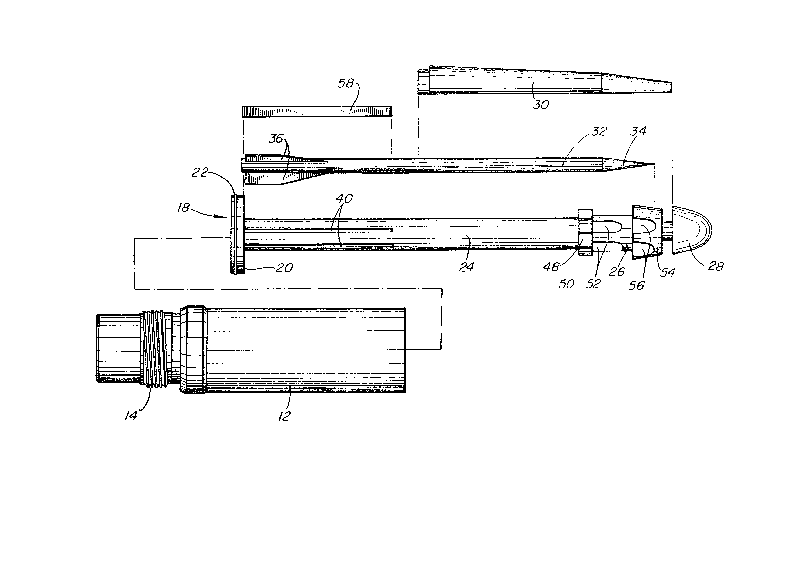Some of the information on this Web page has been provided by external sources. The Government of Canada is not responsible for the accuracy, reliability or currency of the information supplied by external sources. Users wishing to rely upon this information should consult directly with the source of the information. Content provided by external sources is not subject to official languages, privacy and accessibility requirements.
Any discrepancies in the text and image of the Claims and Abstract are due to differing posting times. Text of the Claims and Abstract are posted:
| (12) Patent: | (11) CA 1266202 |
|---|---|
| (21) Application Number: | 1266202 |
| (54) English Title: | MULTIPLE FLECHETTE WARHEAD |
| (54) French Title: | OGIVE DE FUSEE A PLUSIEURS FLECHETTES |
| Status: | Term Expired - Post Grant |
| (51) International Patent Classification (IPC): |
|
|---|---|
| (72) Inventors : |
|
| (73) Owners : |
|
| (71) Applicants : |
|
| (74) Agent: | BATTISON WILLIAMS DUPUIS |
| (74) Associate agent: | |
| (45) Issued: | 1990-02-27 |
| (22) Filed Date: | 1986-06-05 |
| Availability of licence: | N/A |
| Dedicated to the Public: | N/A |
| (25) Language of filing: | English |
| Patent Cooperation Treaty (PCT): | No |
|---|
| (30) Application Priority Data: | None |
|---|
ABSTRACT
A sub-munition warhead contains several flechettes
arranged in a circumferential pattern. A canister with a length
less than that of the flechettes surrounds the rear ends of the
flechettes. A frangible fairing joins the canister to a small
diameter nose cone. An indexer adjacent the nose cone and a sabot
for each flechette retain the flechettes in position on a piston
joining the canister and the nose cone. The warhead is normally
launched with a rocket motor. It is spun so that on burnout, the
warhead is travelling at high speed and spinning. On burnout, a
fuze is ignited and the piston is propelled down the canister.
This drives the flechettes forwardly, rupturing the fairing and
allowing the flechettes to separate for independent flight to a
target.
Note: Claims are shown in the official language in which they were submitted.
Note: Descriptions are shown in the official language in which they were submitted.

2024-08-01:As part of the Next Generation Patents (NGP) transition, the Canadian Patents Database (CPD) now contains a more detailed Event History, which replicates the Event Log of our new back-office solution.
Please note that "Inactive:" events refers to events no longer in use in our new back-office solution.
For a clearer understanding of the status of the application/patent presented on this page, the site Disclaimer , as well as the definitions for Patent , Event History , Maintenance Fee and Payment History should be consulted.
| Description | Date |
|---|---|
| Inactive: IPC deactivated | 2011-07-26 |
| Inactive: Expired (old Act Patent) latest possible expiry date | 2007-02-27 |
| Inactive: Office letter | 2007-02-13 |
| Inactive: IPC from MCD | 2006-03-11 |
| Inactive: First IPC derived | 2006-03-11 |
| Revocation of Agent Requirements Determined Compliant | 2005-04-11 |
| Appointment of Agent Requirements Determined Compliant | 2005-04-11 |
| Inactive: Office letter | 2005-04-11 |
| Inactive: Office letter | 2005-04-11 |
| Inactive: Agents merged | 2004-04-01 |
| Inactive: Office letter | 2001-05-31 |
| Appointment of Agent Requirements Determined Compliant | 2001-05-31 |
| Inactive: Office letter | 2001-05-31 |
| Revocation of Agent Requirements Determined Compliant | 2001-05-31 |
| Letter Sent | 1998-03-12 |
| Grant by Issuance | 1990-02-27 |
There is no abandonment history.
| Fee Type | Anniversary Year | Due Date | Paid Date |
|---|---|---|---|
| MF (category 1, 8th anniv.) - standard | 1998-02-27 | 1998-02-24 | |
| MF (category 1, 9th anniv.) - standard | 1999-03-01 | 1998-02-27 | |
| MF (category 1, 10th anniv.) - standard | 2000-02-28 | 2000-02-07 | |
| MF (category 1, 11th anniv.) - standard | 2001-02-27 | 2000-12-11 | |
| MF (category 1, 12th anniv.) - standard | 2002-02-27 | 2002-02-01 | |
| MF (category 1, 13th anniv.) - standard | 2003-02-27 | 2003-02-03 | |
| MF (category 1, 14th anniv.) - standard | 2004-02-27 | 2003-12-30 | |
| MF (category 1, 15th anniv.) - standard | 2005-02-28 | 2005-02-22 | |
| MF (category 1, 16th anniv.) - standard | 2006-02-27 | 2006-01-03 | |
| 2007-01-24 |
Note: Records showing the ownership history in alphabetical order.
| Current Owners on Record |
|---|
| HER MAJESTY THE QUEEN, IN RIGHT OF CANADA, AS REPRESENTED BY THE MINISTE |
| Past Owners on Record |
|---|
| MAURICE A. LAVIOLETTE |
| WILLIAM J. ROBERTSON |